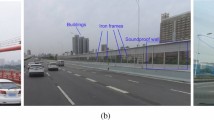Abstract
In this letter, we propose a new stochastic model for the time variation of wireless channel inside the moving vehicle. In the classical Jakes’ model, the receiver is assumed to move at a certain speed relative to the surrounding reflectors. However, when the receiver is inside a moving vehicle, the receiver is relatively static to the surrounding reflectors, while the reflectors (as well as the receiver) move at a certain speed relative to the ground. A novel stochastic model for this kind of channel time variation is proposed in this letter, which can be employed to model the channel time variation inside the moving vehicle in a more accurate manner.



Similar content being viewed by others
References
Pateromichelakis, E., Shariat, M., ul Quddus, A., et al. (2013). On the evolution of multi-cell scheduling in 3GPP LTE/LTE-A. IEEE Communications Surveys and Tutorials, 15(2), 701–717.
GPP TR 36.814 (2010). Further advancements for E-UTRA physical layer aspects, v.9.0.0. www.3gpp.org.
Liu, L., Zhu, G., & Wang, L. (2012). Interference analysis and novel fractional frequency reuse scheme in LTE networks. Journal of Harbin Institute of Technology (New Seriers), 19(4), 104–109.
Trungtan, N., Meng, W., Wang, H., et al. (2012). Performance analysis on channel capacity in cooperative MIMO system. Journal of Harbin Institute of Technology (New Seriers), 19(3), 61–67.
Liu, Z., Li, X., & Ji, H. (2014). A utility-based scheduling scheme for MIMO-OFDMA downlink systems. Journal of Harbin Institute of Technology (New Seriers), 2, 1–5.
Zhou, Y., Adachi, F., Wang, X., et al. (2012). Guest editorial broadband wireless communications for high speed vehicles. IEEE Journal on Selected Areas in Communications, 30(4), 673–674.
Liu, L., Tao, C., Qiu, J., et al. (2012). Position-based modeling for wireless channel on high-speed railway under a viaduct at 2.35 GHz. IEEE Journal on Selected Areas in Communications, 30(4), 834–845.
Zhou, Y., Pan, Z.G., Hu J.L. et a1. (2011). Broadband wireless communications on high speed trains. In IEEE on wireless and optical communication conference, USA (pp. 1–6).
Dai, L., Wang, Z., & Yang, Z. (2012). Time-frequency training OFDM with high spectral efficiency and reliable performance in high speed environments. IEEE Journal on Selected Areas in Communications, 30(4), 695–707.
Wang, J., Zhu, H., & Gomes, N. J. (2012). Distributed antenna systems for mobile communications in high speed trains. IEEE Journal on Selected Areas in Communications, 30(4), 675–683.
Zhu, X., Chen, S., Haijing, H., et al. (2013). TDD-based mobile communication solutions for high-speed railway scenarios. IEEE Wireless Communications, 20(6), 22–29.
Liu, Y., Tan, Z., Hu, H., Cimini, L. J., & Li, G. Y. (2014). Channel estimation for OFDM. IEEE Communication Survey and Tutorials, 16(4), 1891–1908.
Rappaport, T. S. (2002). Wireless communications principles and practice (2nd ed., pp. 204–226). Upper Saddle River: Prentice Hall press.
Jakes, W. C. (1993). Microwave mobile communications (pp. 123–174). New York: IEEE Press.
Goldsmith, A. (2005). Wireless communications (pp. 58–70). Cambridge: Cambridge Press.
Acknowledgments
This work was supported by the National Natural Science Foundation of China (Grant No. 61302106), Natural Science Foundation of Hebei Province (No. F2014502029) and the Fundamental Research Funds for the Central Universities (No. 2016MS98).
Author information
Authors and Affiliations
Corresponding author
Rights and permissions
About this article
Cite this article
Han, D., Liu, Y. & Lin, F. Modeling the Channel Time Variation Inside Moving Vehicle. Wireless Pers Commun 94, 889–897 (2017). https://doi.org/10.1007/s11277-016-3655-4
Published:
Issue Date:
DOI: https://doi.org/10.1007/s11277-016-3655-4




